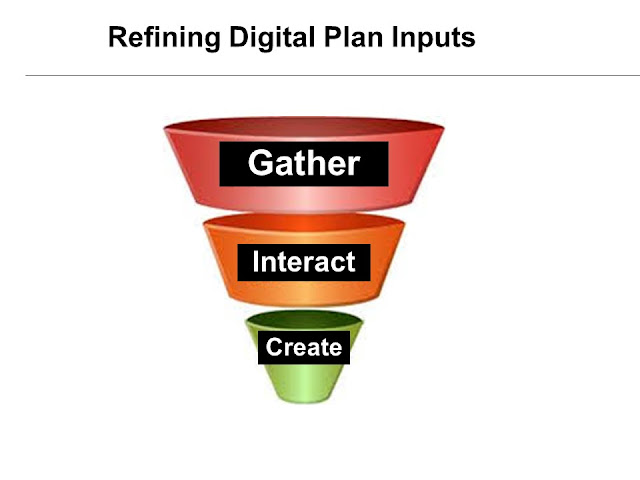The technologies are classified by color to show maturity and safety. Green means there are many stable implementations in the real world. Yellow means that there are fewer implementations and some risk may be involved. Red means that you will likely be a pioneer with few skills available or the technology is still rapidly evolving. There is also a short description of each class of technologies for readers. Sometimes business units are created to evaluate these technologies, but most organizations like to have architects on staff to evaluate emerging technologies. Architects are generally housed in the IT department, but the digital movement could change the reporting relationship.
Secure Mobile & Social Collaboration:
As technology moves out to everyone, a secure mobile experience, that revolves around the individual and the network for collaboration to reach their desired outcomes, must be created. This is the most logical place for organizations to start embracing digital, but there are many organizations that have made this jump for differentiation and opportunity or just to stay in the game.
Customer Journey Mapping:
Organizations are self centered and focused on their own goals to the detriment to their customers and other constituents. This is not a surprise to anyone who has ever had to interact with many organizations. By mapping customer journey, from their perspectives, organizations can optimize their touch points with these customers for a better set of balanced outcomes.
Signal & Pattern Processing:
Organizations have to be aware of opportunities and threats to their operations, so being able recognize important signals and patterns is essential in the ever changing digital world. Keeping track of every signal or emerging pattern will be a difficult task and must be done in a near real time fashion. As more more intelligence and autonomy gets pushed to the edge of organizations, signal and pattern detection become more important.
Big & Fast Data:
In order to have make better decisions across and inside of known and sometimes unknown contexts, larger amounts of data moving at higher speeds than the norm today must be stored for further analysis. The analysis could range from immediate to later trend analysis of large amounts of complex data interacting in moving contexts. Managing and storing this mass of data is one of the major functions of big and fast data.
Web Scale Cloud Integration:
Cloud integration is the process of configuring multiple applications and processes to share data in the cloud. In a network that incorporates cloud integration, diverse applications communicate either directly or through third-party software. Web scale includes not only data, but events, images, interfaces etc., but handles large amounts of data and data types in hyper speed fashion.
Advanced Poly-Analytics & Mining:
This is a grouping of many analytic techniques used to look at past trends, sense current conditions and predict future outcomes for better decisions and actions in order to create better and balanced outcomes for all constituents. As intelligence is pushed to the edge, these techniques combined with cognitive logic/knowledge (Cogs) will be used to optimize locally without negatively affecting global outcomes.
Internet of Things:
The IoT is traditionally defined as the network of physical objects or things embedded with electronics, software, sensors and network connectivity, which enables these objects to collect and exchange data. This enables sub-nano second response times, but is often combined with humans to notify or enhance actions of both humans and machines.
3D Printing:
This is a processes also known as additive manufacturing that is used to synthesize a three-dimensional object. In 3D printing, successive layers of material are formed under computer control from a virtual image to create an object. These objects can be of any shape or geometry and sometimes materials. The objects are produced from a 3D model or other electronic source. A 3D printer is a type of industrial robot.
Augmented Visualization & Reality:
This is a live direct or indirect view of a physical, real-world environments whose elements are supplemented or augmented by computer-generated sensory input such as sound, video, graphics or various forms of data. It is a mediated reality, in which a view of reality, such as business results, is modified by a computer to enhance or focus the view. As a result, the technology functions by enhancing ones current perception of reality by surrounding real world objects with information encouraging user interaction.
Cognitive Computing & Robotics:
This is the at the minimum the simulation of human thought processes in a computerized model. It involves self learning that involves data mining, pattern recognition and natural language processing to mimic the way the human brain works. At a maximum cognition is added to mechanical actions embodied in a robot either specialized or generalized.
Context Rich Policy, Rule & Constraint Management:
With more computing components (software or machines) making localized and distributed decisions or actions, there is a need to establish boundaries or constraints that these autonomous components (agents) need to respect and enable. These may be governance or policy related constraints that must not be violated unless they appear in a new or evolving context. Technology can be used to manage these rules and deal with quick change scenarios.
Bio Tech & Nano Materials:
This is the use of living systems to make technological applications or products. Combining bio research with various fields of nanotechnology, such as small biological machines, shows potential for digital advancement in certain industries. Since there are ethical issues surrounding this topic. care must be exercised in the use.
Net; Net:
This list should be considered at various times during the migration to the new digital era. Of course this list will change over time as well as the relative need and maturity of each class of technologies.
Additional Reading on Creating a Digital Plan:
http://jimsinur.blogspot.com/2015/11/the-top-seven-ingredients-in-digital.html
http://jimsinur.blogspot.com/2015/11/the-top-seven-digital-plan-inputs.html
Additional Reading on Digital:
http://jimsinur.blogspot.com/2015/10/what-is-digital-business.html
http://jimsinur.blogspot.com/2015/11/is-digital-for-everything.html
http://jimsinur.blogspot.com/2015/11/getting-to-situational-business.html
http://jimsinur.blogspot.com/2015/10/selecting-technology-partners-for-your.html
http://jimsinur.blogspot.com/2015/10/creating-digital-business-platform.html









